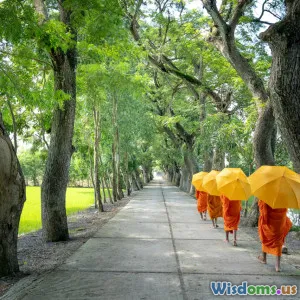
Meditation Techniques Every Seeker Should Try on Pilgrimage
9 min read Explore transformative meditation techniques perfect for enhancing spiritual pilgrimages and personal growth. (0 Reviews)
Meditation Techniques Every Seeker Should Try on Pilgrimage
Embarking on a pilgrimage is often described as both a physical and spiritual journey — a rare chance to step outside the confines of everyday distractions to explore deeper states of self-awareness and connection. Meditation stands as a powerful companion in this transformative experience, helping seekers like you harness the unique environment of a pilgrimage to deepen inner peace, insight, and clarity.
In this comprehensive guide, we will explore meditation methods specifically suited for the pilgrimage context, incorporating historical significance, modern practice, and practical advice. Each technique offers a different gateway to mindfulness and spiritual growth, applicable regardless of your tradition or experience level.
Why Meditation on a Pilgrimage?
Historically, sacred journeys to places like the Camino de Santiago in Spain, the Kumbh Mela in India, or the Shikoku Pilgrimage in Japan are more than just geographical travels. They are soul journeys where the physical movement through sacred spaces mirrors inner transformation. Meditation amplifies this effect:
- Heightened Awareness: Pilgrimage sites brim with spiritual energy—meditation helps absorb this, tuning your mind to subtler dimensions.
- Enhanced Reflection: Walking long distances alone or in groups can bring unresolved emotions to light; meditation provides tools to process and integrate these insights.
- Support for Physical Endurance: Techniques like focused breathing can alleviate pain or fatigue, improving stamina during demanding parts of the pilgrimage.
As Jon Kabat-Zinn eloquently puts it, "You can’t stop the waves, but you can learn to surf." Meditation empowers you to navigate the emotional and spiritual undulations encountered on pilgrimage with grace.
1. Mindfulness Meditation: Anchoring in the Present
What is Mindfulness Meditation?
Mindfulness meditation revolves around intentionally bringing your attention to the present moment, observing sensations, thoughts, and emotions without judgment. It roots you firmly in the "here and now," amid the sights, sounds, and smells of pilgrimage.
How to Practice on Pilgrimage
While walking between stops, pause to focus on your breath or the rhythm of your footsteps. Notice the way every muscle moves, the feeling of the earth beneath your shoes, or the chorus of birds overhead. Travelers on the Camino de Santiago have shared that this rooted awareness transformed daily trudge into a moving meditation.
Benefits
Regular practice can reduce anxiety, elevate mood, and improve concentration — essential benefits when navigating crowds or dealing with physical strain.
Real-World Insight
Neuroscientific studies have shown that mindfulness can shift brain function in areas linked to emotional regulation and stress reduction — key to enduring a challenging pilgrimage with equanimity.
2. Mantra Meditation: Harnessing Sacred Sound
Understanding Mantra Meditation
Repetition of sacred sounds or phrases (mantras) from traditions worldwide—such as "Om," "Om Mani Padme Hum," or the Jesus Prayer—anchors focus and elevates vibration.
Practical Use During Pilgrimage
Whether seated by a sacred shrine or quietly during rest, softly chanting or mentally repeating a mantra can deepen your connection to the sacred environment. At sites like India's Varanasi, pilgrims frequently engage in mantra chanting, creating a vibrant tapestry of communal spiritual energy.
Benefits
Mantras can quiet mental chatter, foster focus, and invoke a sense of divine presence. They also connect personal practice to ancestral spiritual lineages, adding layers of meaning.
Example
A research study conducted by Oxford University found that mantra meditation can significantly lower blood pressure and mental stress, showcasing its holistic healing potential.
3. Walking Meditation: Embracing Movement as Mindfulness
The Essence of Walking Meditation
Unlike traditional sitting meditation, walking meditation involves deliberately syncing breath and movement in a mindful rhythm.
How to Apply on a Pilgrimage
Take slow, deliberate steps, paying close attention to footfalls. Feel the rise and fall of your body as you walk, each movement serving as an anchor. Many pilgrims on the Shikoku Trail describe this as an embodied prayer, bringing intense grounding.
Benefits
Walking meditation can be a moving refuge from physical and mental fatigue. It allows meditative practice even during the commute between sacred sites, helping maintain spiritual continuity.
Scientific Insight
Studies in behavioral science highlight that mindful walking can activate both the mind and body, improving mood and cognitive flexibility.
4. Visualization Meditation: Creating Sacred Inner Landscapes
Defining the Practice
Visualization involves imagining places, symbols, or spiritual figures to foster mental clarity and inspiration.
Applying as a Pilgrim
Before reaching a well-known shrine, for example, visualize yourself approaching peacefully, full of gratitude. Alternatively, imagine a protective light enveloping you during challenging stretches.
Benefits
Visualization aids motivation, calms nerves before high-energy rituals, and can deepen faith by mentally rehearsing sacred encounters.
Historical Example
Tibetan Buddhist practitioners employ visualization in pilgrimage preparation, mentally rehearsing complex rituals and sacred journeys to amplify their real-world experience.
5. Breath Awareness Meditation: The Life Force
What It Is
This simple yet profound practice highlights the natural ebb and flow of breath, using it as a steady focal point.
Practice Tips on Pilgrimage
If anxiety strikes or physical exertion overwhelms, pause, close your eyes if safe, and take slow, deliberate breaths. Count breaths to stabilize attention.
Benefits
Breath awareness lowers cortisol levels, diminishing stress and supporting cardiovascular health—both crucial on strenuous spiritual treks.
Supporting Data
A study published in the Journal of Alternative and Complementary Medicine demonstrates that breath-focused meditation can reduce inflammatory markers in the body.
Integrating Meditation into Your Pilgrimage Routine
Here are practical suggestions for weaving these techniques into your sacred journey:
- Start small: Dedicate five minutes daily to meditation, gradually increasing time as comfort builds.
- Create ritual: Link meditation to regular pilgrimage activities, such as before beginning daily walks or after arrival at shrines.
- Journaling: Post-meditation reflections can illuminate subtle insights and personal growth.
- Community: Join fellow seekers for group meditation; shared energy often deepens the experience.
Conclusion: Meditation as a Pilgrimage Multiplier
Pilgrimage is as much about inner transformation as outer travel. By applying meditation techniques like mindfulness, mantra chanting, walking meditation, visualization, and breath awareness, seekers can cultivate profound presence, resilience, and spiritual depth.
In a world filled with distraction and haste, meditation reclaims the pilgrimage as an opportunity for slow, sacred awakening. The techniques shared are not confined to any single tradition but are universal tools that can enrich both the journey and the seeker.
As you prepare for your next sacred journey, embrace these meditative practices and witness how they transform every step into an act of devotion and every breath into a moment of awakening.
Embark with openness, meditate with intention, and arrive renewed.
Rate the Post
User Reviews
Popular Posts

















